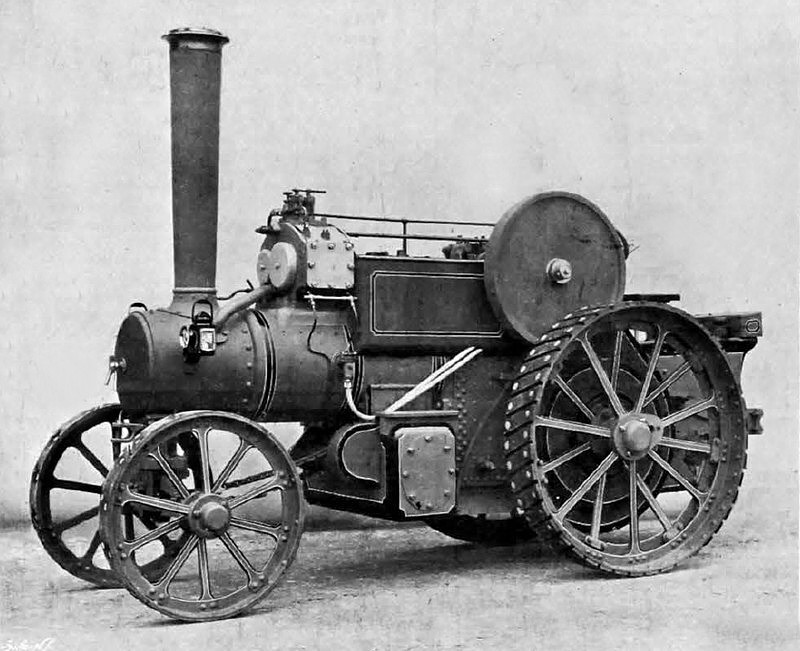|
Title: |
1917 Article-Aveling & Porter, Compound Steam Agricultural Traction Engine |
|
Source: |
The Engineer Magazine, 21 Dec 1917, pg. 533 |
|
Insert Date: |
1/21/2013 4:33:41 PM |
AVELING AND PORTER
The agricultural tractor which is made by Aveling and Porter, Limited. of Rochester, is illustrated in Fig. 1. It will be observed that in outward appearance it closely resembles the road locomotives and rollers with which the firm‘s name has been connected with so many years. It, however, is smaller and weighs a good deal less, the tare weight being about five tons. The driving wheels, which are 5 ft. in diameter, are l2 in. wide, but for working on soft ground detachable extension rings with the necessary spuds are provided. These rings are 6 in. wide, and with them the width of the wheels is increased to 18 in.
The engine is of the compound type, with cylinders 4¼ in. and 6 in. in diameter by 8 in. stroke. The boiler is designed to work at 200lb. pressure per square inch, has 27 tubes. 1¾ in. diameter by 3 ft. 9½ in.
long. The grate area is 3 square feet and the heating surface 63.4 square feet, and the fire-box being of the Belpaire type. The normal speed of the engine is 225 revolutions per minute, and at that speed 21 brake horsepower is developed normally at the flywheel, which is 3ft. in diameter and is slightly rounded for belt driving. If required a governor can be fitted to the engine when it is desired to drive machinery
from the flywheel.
Water is carried in two tanks. one in the tender and one under the boiler, the combined capacity of which is 130 gallons. For filling them a water lifter with 26ft. of India-rubber hose and nozzle is supplied. A feed pump, which is driven from the engine by means of speed reduction gearing, is bolted to the left-hand horn plate. The pump check valve is mounted on the barrel of the boiler and is fitted to a solid steel base riveted to and tested with the boiler. As an additional means of feeding the boiler there is an injector.
The front wheels are 3 ft. 4 in. in diameter and 5 in. wide. Steering, which is effected by means of a hand wheel manipulated from the foot-plate, is brought about through worm and wheel gearing. The chain has a worm cast on it so as to ensure that the chain may be easily wound. Brakes, which act on the inside rims of the driving wheels, and are worked from the foot-plate, are provided. A draw-bracket for the attachment of a plough or other implement is arranged at the back of the tender, where it is stayed direct to the horn plates on either side. Compensating gear, which is of cast steel and fitted with three bevel pinions, is provided. The right-hand driving wheel is double pinned to the boss of the winding drum. The later is made of cast steel and carries 50 yards of flexible plated steel wire rope, there being the necessary brackets and guide rollers fitted on the tender to enable to rope to be used effectively.
The engine is mounted on the firm’s arrangement of laminated steel springs, which are fitted, to both hind and front axles. The hind axle is mounted on a double spring extending across the engine, the tension of which can be adjusted by one central bolt. The tractor is provided with two traveling speeds, viz., 2½ and 5 miles per hour, respectively. The crank shaft, counter-shaft, and driving axle are carried by steel brackets formed out of the side plates of the fire-box, which are extended upwards and backwards in one piece so as to carry the shafts in the most convenient positions. This arrangement is patented. The first and second motion wheels are machine cut, and the design is such that no two speed gear wheels can be in mesh at the same time. The gear wheels can be readily disconnected when it is desired to drive machinery from the fly-wheel. Link motions, with double lifting levers, are provided for reversing.
The serviceable little engine will haul a three-furrow plough under normal conditions. When used for road haulage, it can cover from 40 to 50 miles per day, at, so the makers inform us, an approximate cost of from 15 s. to 16 s., this figure including allowances for driver’s wages, fuel, depreciation, wear and tear, and interest on capital. Coal, or more preferably coke, is the fuel employed.
Image Courtesy of Grace's Guide
http://www.gracesguide.co.uk/File:Im1917EnV124-p533.jpg |
|
 1917 Aveling & Porter, Compound Steam Agricultural Traction Engine
1917 Aveling & Porter, Compound Steam Agricultural Traction Engine
|
|